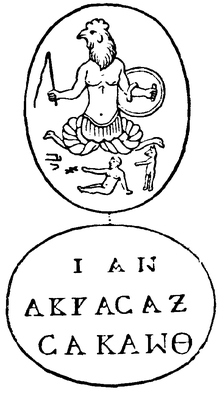Anguiped


The Anguiped is a kind of divinity that is often found on magical amulets from the Greco-Roman period, and is characterized by having serpents for legs.
Abraxas, the most common kind of Anguiped, is depicted as a creature with the head of a rooster and snakes for legs, symbolism thought to be of Persian origin. Sometimes inscribed below is Iao, a form of the Tetragrammaton - the four letters used to represent the name of the God of Judaism. Such amulets as well as the usage of the name Iao repeatedly in magical papyri, curse tablets, gems, and other amulets, provide evidence of syncretist cults combining elements of Judaism with paganism. In the Talmud, people who turned away from Judaism to such cults are referred to as minim - often translated as "heretics" or "apostates".
| Wikimedia Commons has media related to Anguipeds. |
Further reading
- Merkelbach, Reinhold; Totti, Maria, eds. (1990–1992). Abrasax: Ausgewählte Papyri Religiösen und Magischen Inhalts (in German). Westdeutscher Verlag.
- Barrett, Caitlín E. "Plaster Perspectives on "Magical Gems": Rethinking the Meaning of "Magic"". Cornell Collection of Antiquities. Cornell University Library. Archived from the original on 2015-05-26. by Internet Archive on 26 May 2015.
- Nagy, Á.M (2012). "Daktylios pharmakites. Magical Healing Gems and Rings in the Graeco-Roman World". In Csepregi, Ildikó; Burnett, Charles. Ritual healing : magic, ritual, and medical therapy from antiquity until the early modern period. Firenze: SISMEL edizioni del Galluzzo. ISBN 9788884504432.